Effects of Using Aluminum Sulfate as an Accelerator and Acrylic Acid, Aluminum Fluoride, or Alkanolamine as a Regulator in Early Cement Setting
Abstract
1. Introduction
2. Experimental
2.1. Raw Materials
2.2. Instruments and Methods
2.2.1. Determination of Setting Time
2.2.2. Determination of Compressive and Flexural Strengths
2.2.3. Characterizations
3. Results and Discussion
3.1. Analysis of Setting Time and Mechanical Strength
3.2. Analysis of Chemical Composition
3.3. Analysis of Element Chemical State
3.4. Analysis of Crystallinity and Thermal Stability
4. Conclusions
Author Contributions
Funding
Institutional Review Board Statement
Informed Consent Statement
Data Availability Statement
Conflicts of Interest
References
- Phair, J.W. Green chemistry for sustainable cement production and use. Green Chem. 2006, 8, 763–780. [Google Scholar] [CrossRef]
- Wang, J.; Niu, D.; Zhang, Y. Microstructure and mechanical properties of accelerated sprayed concrete. Mater. Struct. 2016, 49, 1469–1484. [Google Scholar] [CrossRef]
- Chakraborty, S.; Jo, B.W.; Sikandar, M.A. Hydration mechanism of the hydrogen-rich water based cement paste. J. Phys. Chem. C 2016, 120, 8198–8209. [Google Scholar] [CrossRef]
- Andersen, M.D.; Jakobsen, H.J.; Skibsted, J. Characterization of white Portland cement hydration and the C-S-H structure in the presence of sodium aluminate by 27Al and 29Si MAS NMR spectroscopy. Cem. Concr. Res. 2004, 34, 857–868. [Google Scholar] [CrossRef]
- Thomas, J.J.; Jennings, H.M.; Chen, J.J. Influence of nucleation seeding on the hydration mechanisms of tricalcium silicate and cement. J. Phys. Chem. C 2009, 113, 4327–4334. [Google Scholar] [CrossRef]
- Lothenbach, B.; Matschei, T.; Möschner, G.; Glasser, F.P. Thermodynamic modelling of the effect of temperature on the hydration and porosity of Portland cement. Cem. Concr. Res. 2008, 38, 1–18. [Google Scholar] [CrossRef]
- Klur, I.; Jacquinot, J.-F.; Brunet, F.; Charpentier, T.; Virlet, J. NMR cross-polarization when TIS>T1ρ; Examples from silica gel and calcium silicate hydrates. J. Phys. Chem. B 2000, 104, 10162–10167. [Google Scholar] [CrossRef]
- Lee, S.T.; Kim, D.G.; Jung, H.S. Sulfate attack of cement matrix containing inorganic alkali-free accelerator. KSCE J. Civ. Eng. 2009, 13, 49–54. [Google Scholar] [CrossRef]
- Winnefeld, F.; Kaufmann, J.; Loser, R.; Leemann, A. Influence of shotcrete accelerators on the hydration of cement pastes and their impact on sulfate resistance. Constr. Build. Mater. 2021, 266, 120782. [Google Scholar] [CrossRef]
- Amato, I. Concrete solutions. Nature 2013, 494, 300–301. [Google Scholar] [CrossRef]
- Karamalidis, A.K.; Voudrias, E.A. Anion leaching from refinery oily sludge and ash from incineration of oily sludge stabilized/solidified with cement Part I. Experimental result. Environ. Sci. Technol. 2008, 42, 6116–6123. [Google Scholar] [CrossRef]
- Mucsi, G.; Papné, N.H.; Ulsen, C.; Figueiredo, P.O.; Kristály, F. Mechanical activation of construction and demolition waste in order to improve its Pozzolanic reactivity. ACS Sustain. Chem. Eng. 2021, 9, 3416–3427. [Google Scholar] [CrossRef]
- Walling, S.A.; Bernal, S.A.; Gardner, L.J.; Kinoshita, H.; Provis, J.L. Blast furnace slag-Mg(OH)2 cements activated by sodium carbonate. RSC Adv. 2018, 8, 23101–23118. [Google Scholar] [CrossRef] [PubMed]
- Gu, X.; Li, Y.; Qi, C.; Cai, K. Biodegradable magnesium phosphates in biomedical applications. J. Mater. Chem. B 2022, 10, 2097–2112. [Google Scholar] [CrossRef]
- Cuesta, A.; Aranda, M.A.G.; Sanz, J.; de la Torre, Á.G.; Losilla, E.R. Mechanism of stabilization of dicalcium silicate solid solution with aluminium. Dalton Trans. 2014, 43, 2176–2182. [Google Scholar] [CrossRef] [PubMed]
- Miller, S.A.; Myers, R.J. Environmental impacts of alternative cement binders. Environ. Sci. Technol. 2020, 54, 677–686. [Google Scholar] [CrossRef]
- Wang, Y.; Lei, L.; Liu, J.; Ma, Y.; Liu, Y.; Xiao, Z.; Shi, C. Accelerators for normal concrete: A critical review on hydration, microstructure and properties of cement-based materials. Cement Concr. Compos. 2022, 134, 104762. [Google Scholar] [CrossRef]
- Richardson, A. Strength development of plain concrete compared to concrete with a non-chloride accelerating admixture. Struct. Surv. 2007, 25, 418–423. [Google Scholar] [CrossRef]
- Dorn, T.; Blask, O.; Stephan, D. Acceleration of cement hydration—A review of the working mechanisms, effects on setting time, and compressive strength development of accelerating admixtures. Construct. Build. Mater. 2022, 323, 126554. [Google Scholar] [CrossRef]
- Chikh, N.; Cheikh-Zouaoui, M.; Aggoun, S.; Duval, R. Effects of calcium nitrate and triisopropanolamine on the setting and strength evolution of Portland cement pastes. Mater. Struct. 2008, 41, 31–36. [Google Scholar] [CrossRef]
- Wang, Y.; Shi, C.; Ma, Y.; Xiao, Y.; Liu, Y. Accelerators for shotcrete—Chemical composition and their effects on hydration, microstructure and properties of cement-based materials. Constr. Build. Mater. 2021, 281, 122557. [Google Scholar] [CrossRef]
- Prudencio, L.R., Jr. Accelerating admixtures for shotcrete. Cem. Concr. Compos. 1998, 20, 213–219. [Google Scholar] [CrossRef]
- Niu, M.; Li, G.; Zhang, J.; Cao, L. Preparation of alkali-free liquid accelerator based on aluminum sulfate and its accelerating mechanism on the hydration of cement pastes. Constr. Build. Mater. 2020, 253, 119246. [Google Scholar] [CrossRef]
- Han, J.; Wang, K.; Wang, Y.; Shi, J. Study of aluminum sulfate and anhydrite on cement hydration process. Mater. Struct. 2016, 49, 1105–1114. [Google Scholar] [CrossRef]
- Salvador, R.P.; Cavalaro, S.H.P.; Cano, M.; Figueiredo, A.D. Influence of spraying on the early hydration of accelerated cement pastes. Cem. Concr. Res. 2016, 88, 7–19. [Google Scholar] [CrossRef]
- Rincon, J.; Camarillo, R.; Martín, A. Solubility of aluminum sulfate in near-critical and supercritical water. J. Chem. Eng. Data 2012, 57, 2084–2094. [Google Scholar] [CrossRef]
- Feng, X.; Zhang, B.; Chery, L. Effects of low temperature on aluminum (III) hydrolysis: Theoretical and experimental studies. J. Environ. Sci. 2008, 20, 907–914. [Google Scholar]
- Park, H.G.; Sung, S.K.; Park, C.G.; Won, J.P. Influence of a C12A7 mineral-based accelerator on the strength and durability of shotcrete. Cem. Concr. Res. 2008, 38, 379–385. [Google Scholar] [CrossRef]
- Salvador, R.P.; Cavalaro, S.H.P.; Segura, I.; Figueiredo, A.D.; Pérez, J. Early age hydration of cement pastes with alkaline and alkali-free accelerators for sprayed concrete. Constr. Build. Mater. 2016, 111, 386–398. [Google Scholar] [CrossRef]
- Yang, S.; Wang, J.; Cui, S.; Liu, H.; Wang, X. Impact of four kinds of alkanolamines on hydration of steel slag-blended cementitious materials. Constr. Build. Mater. 2017, 131, 655–666. [Google Scholar] [CrossRef]
- Ebina, T.; Iwasaki, T.; Chatterjee, A. Comparative study of XPS and DFT with reference to the distributions of Al in tetrahedral octahedral sheets of phyllosilicates. J. Phys. Chem. B 1997, 101, 1125–1129. [Google Scholar] [CrossRef]
- Romanyuk, O.; Gordeev, I.; Paszuk, A.; Supplie, O.; Stoeckmann, J.P.; Houdkova, J.; Ukraintsev, E.; Bartoš, I.; Jiříček, P.; Hannappel, T. GaP/Si(001) interface study by XPS in combination with Ar gas cluster ion beam sputtering. Appl. Surf. Sci. 2020, 514, 145903. [Google Scholar] [CrossRef]
- Zhao, Z.-P.; Li, M.-S.; Zhang, J.-Y.; Li, H.-N.; Zhu, P.-P.; Liu, W.-F. New chiral catalytic membranes created by coupling UV-photografting with covalent immobilization of salen-Co(III) for hydrolytic kinetic resolution of racemic epichlorohydrin. Ind. Eng. Chem. Res. 2012, 51, 9531–9539. [Google Scholar] [CrossRef]
- Imamura, M.; Matsubayashi, N.; Shimada, H. Catalytically active oxygen species in La1-xSrxCoO3-δ studied by XPS and XAFS spectroscopy. J. Phys. Chem. B 2000, 104, 7348–7353. [Google Scholar] [CrossRef]
- Roychand, R.; De Silva, S.; Law, D.; Setunge, S. High volume fly ash cement composite modified with nano silica, hydrated lime and set accelerator. Mater. Struct. 2016, 49, 1997–2008. [Google Scholar] [CrossRef]

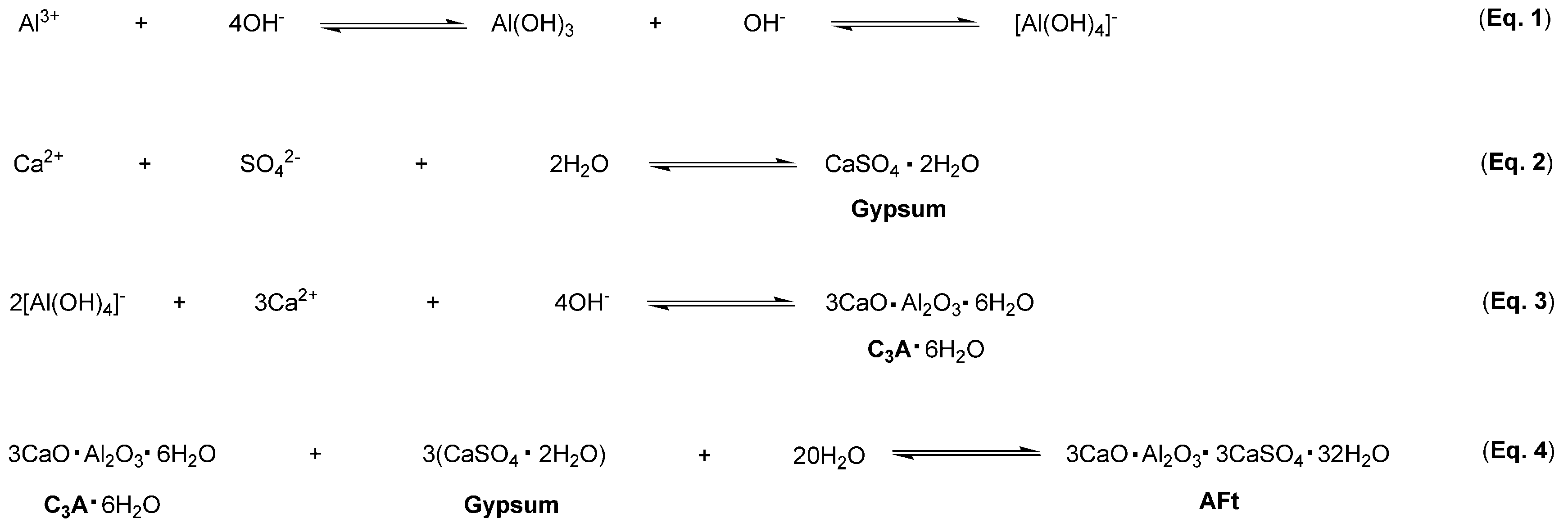
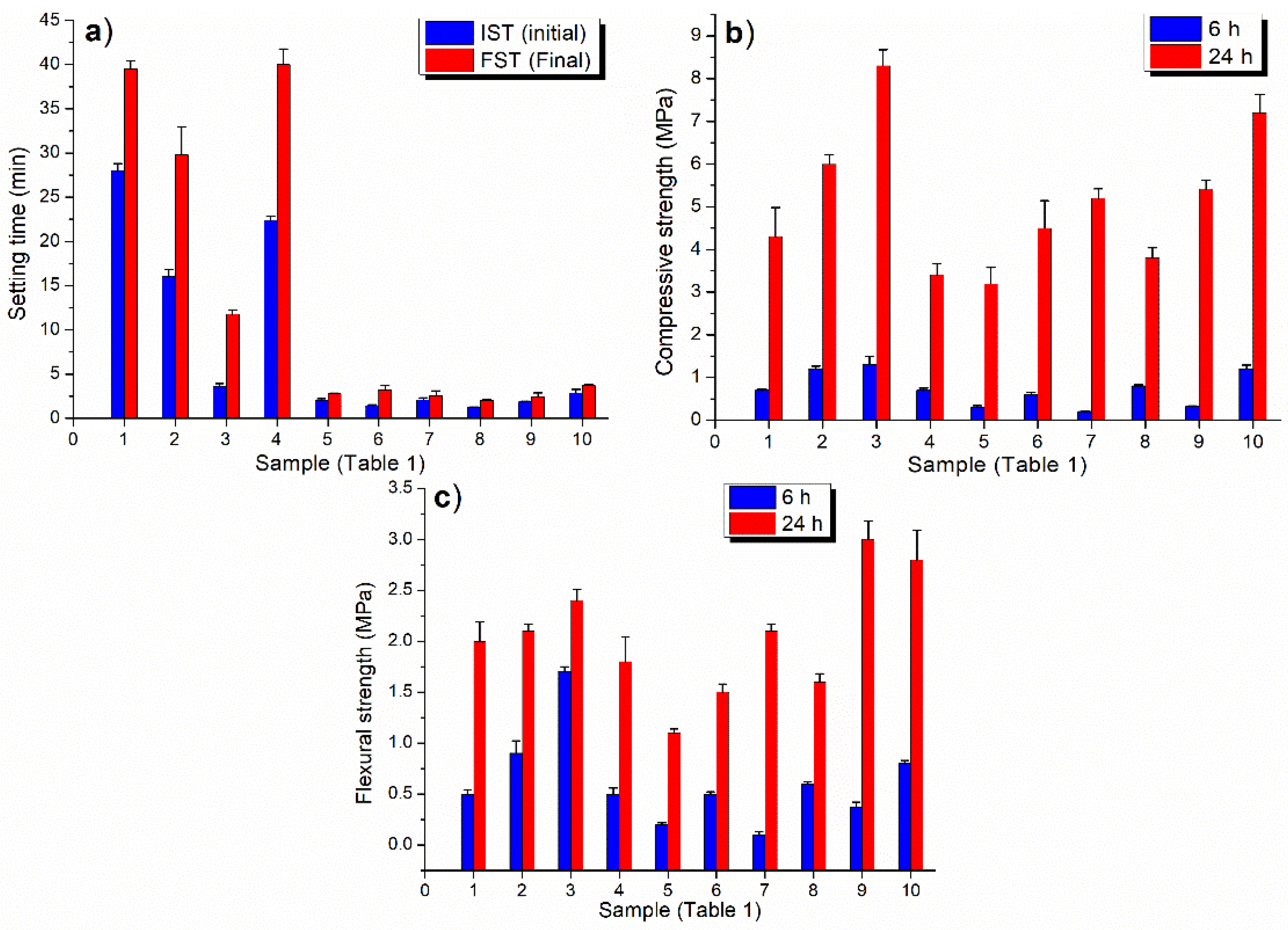
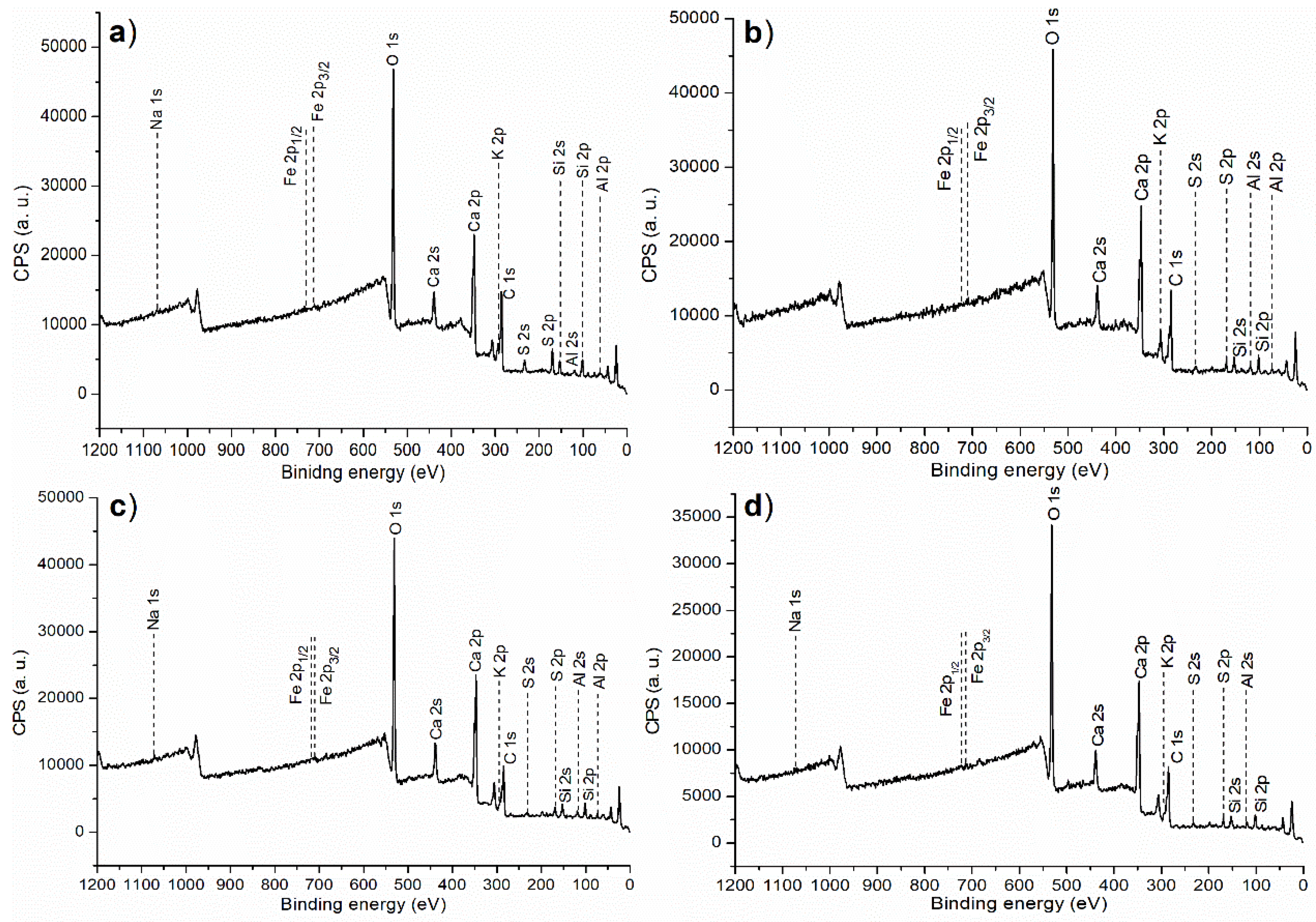
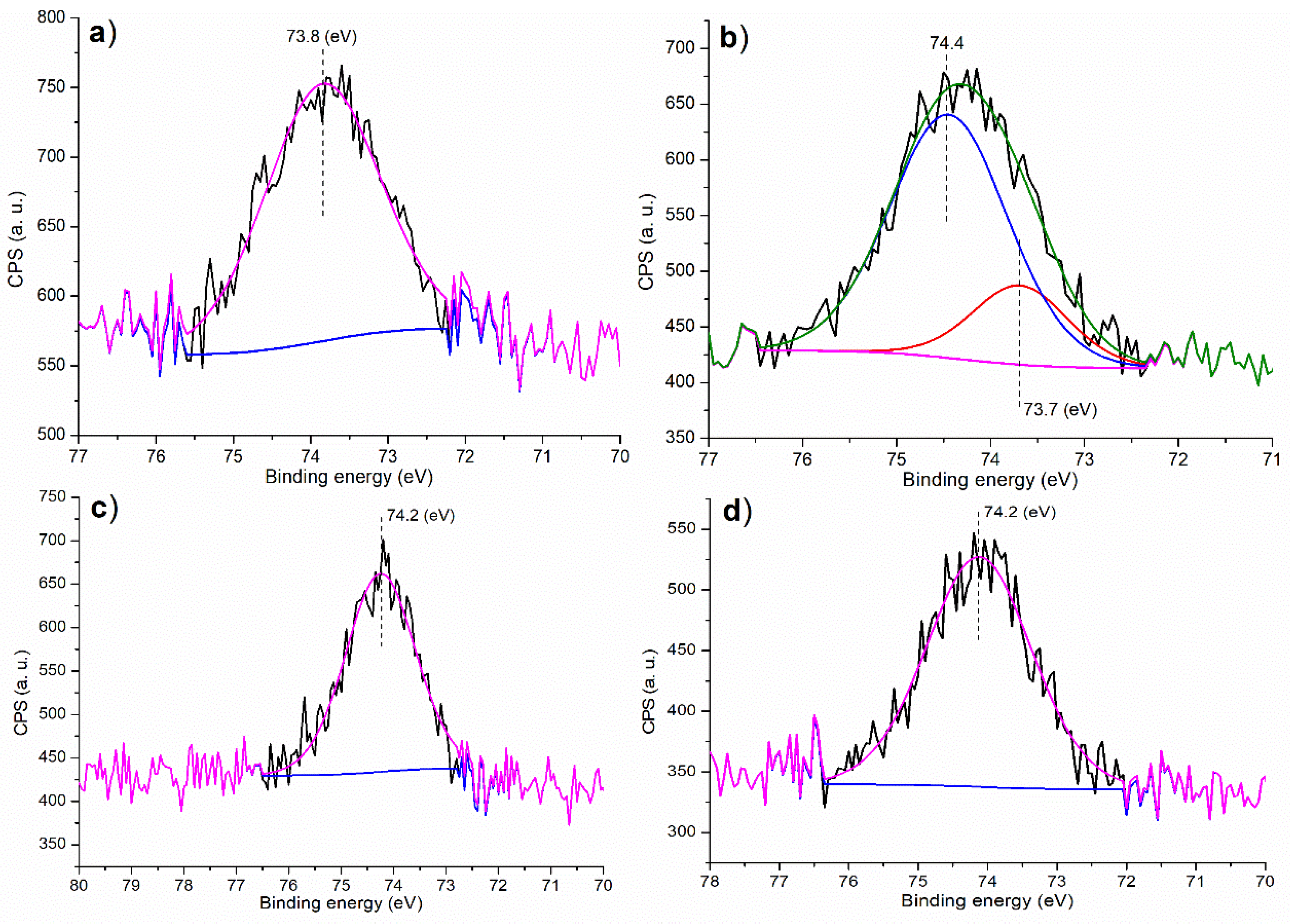
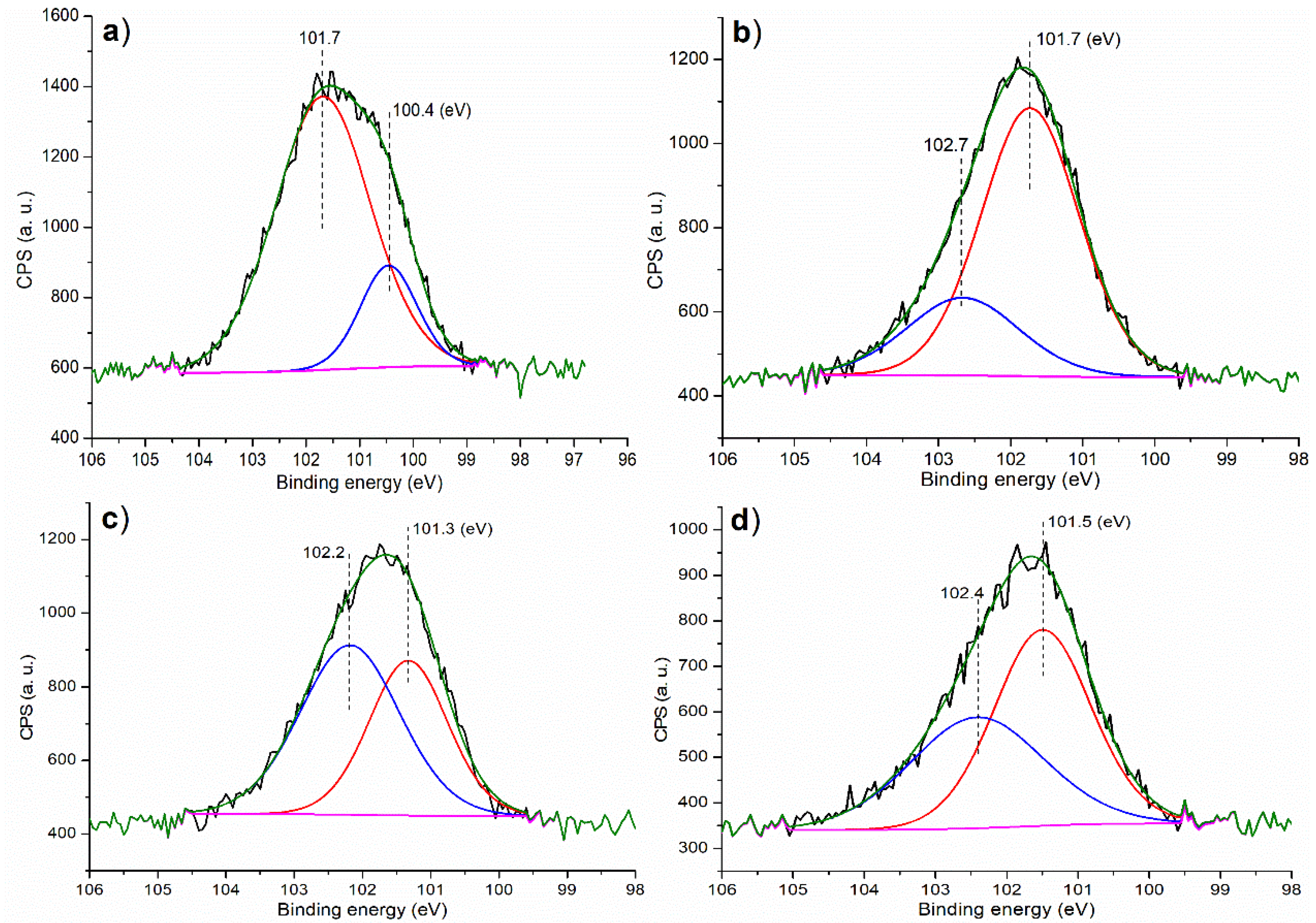
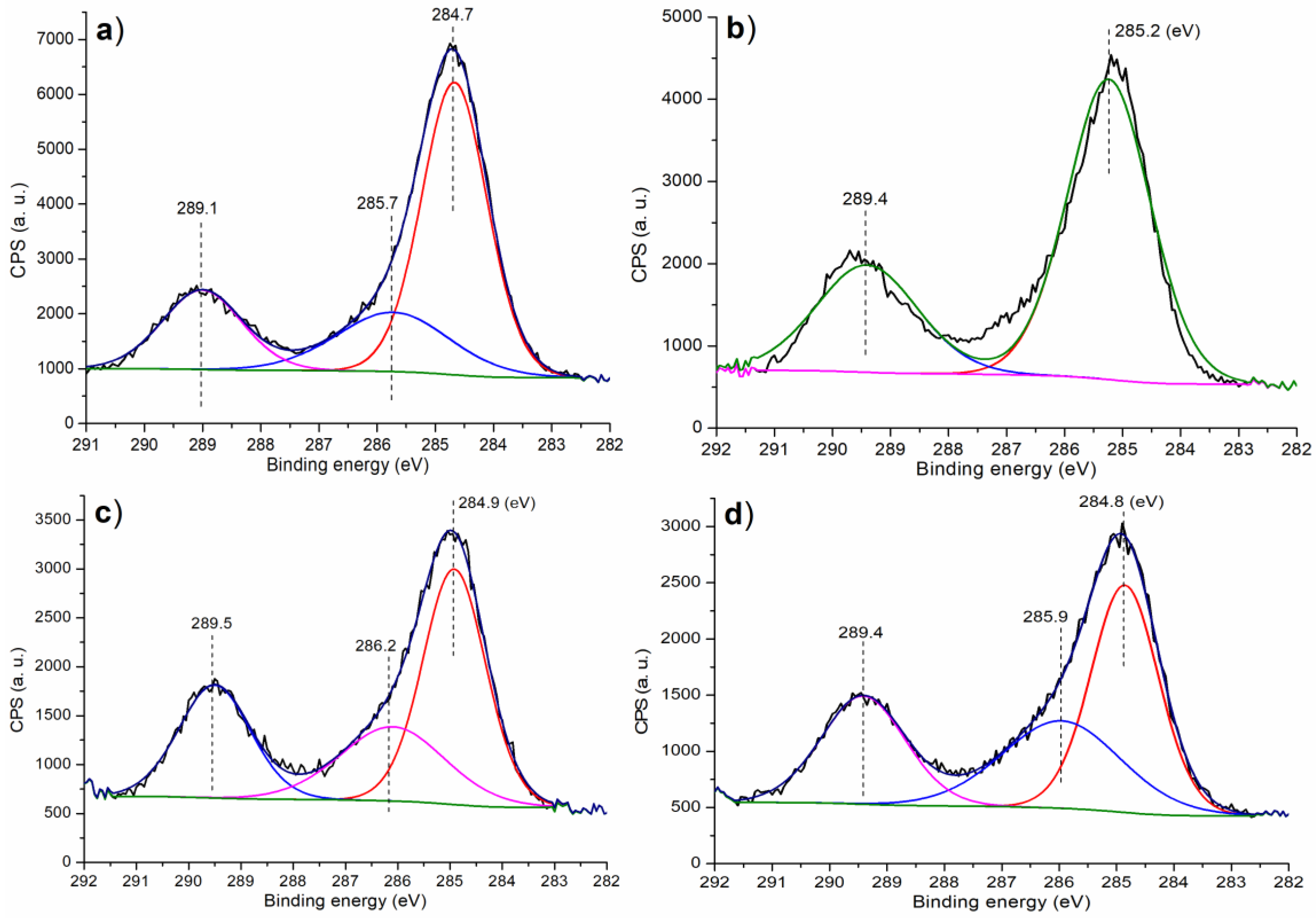


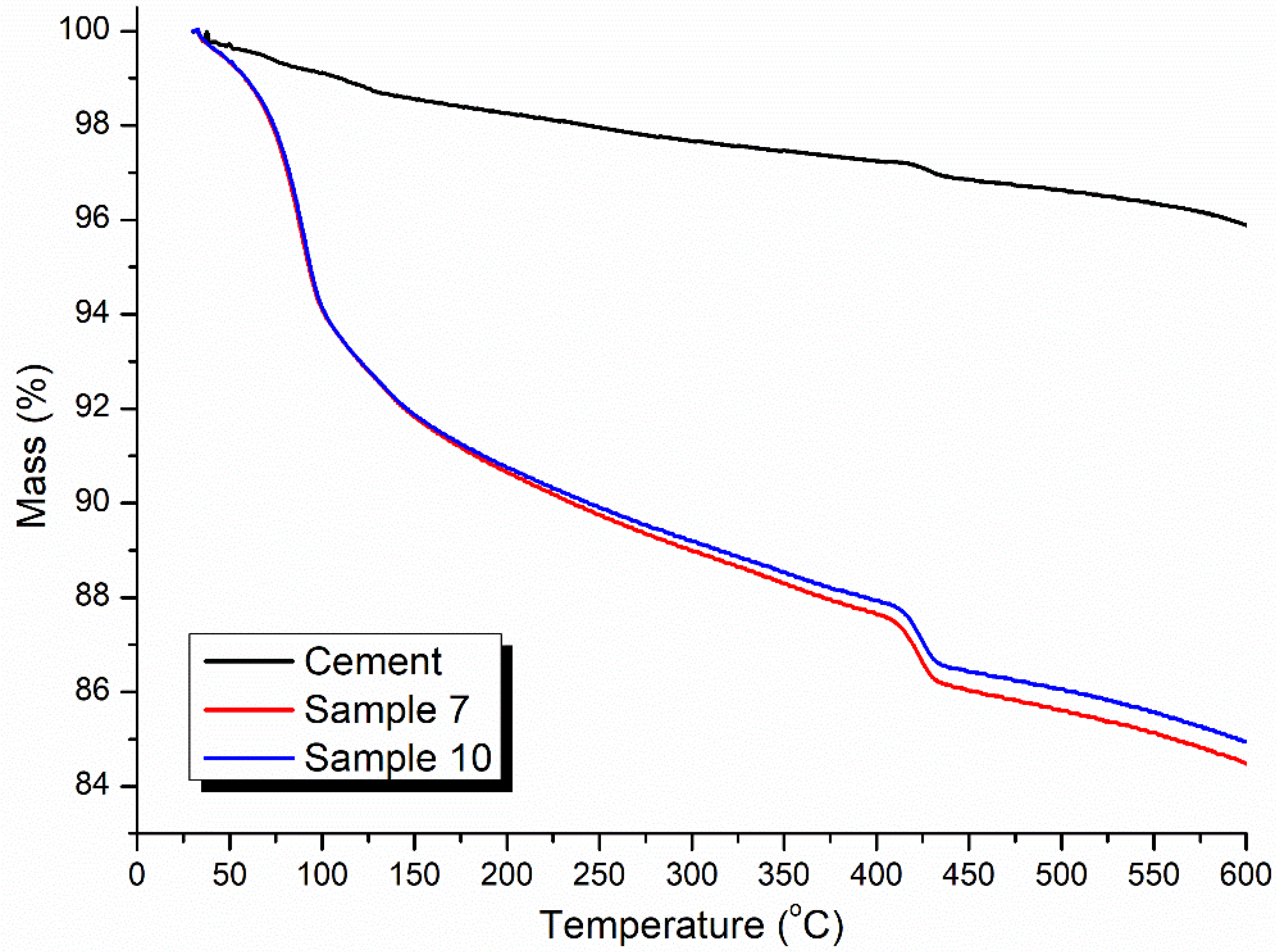
| Sample | Regulator (Mass /g) b | Setting Time/min c | Compressive Strength /MPa d | Flexural Strength /MPa d | |||
|---|---|---|---|---|---|---|---|
| Initial | Final | 6 h | 24 h | 6 h | 24 h | ||
| 1 | None | 28.0 ± 0.80 e | 39.50 ± 0.94 | 0.7 ± 0.03 | 4.3 ± 0.68 | 0.5 ± 0.04 | 2.0 ± 0.19 |
| 2 | AA (8 g) | 16.05 ± 0.81 | 29.79 ± 3.14 | 1.2 ± 0.07 | 6.0 ± 0.22 | 0.9 ± 0.12 | 2.1 ± 0.07 |
| 3 | AA (8 g), AlF3 (3.2 g) | 3.60 ± 0.35 | 11.80 ± 0.41 | 1.3 ± 0.19 | 8.3 ± 0.38 | 1.7 ± 0.05 | 2.4 ± 0.11 |
| 4 | AA (8 g), AlF3 (1.6 g) | 22.38 ± 0.50 | 40.0 ± 1.75 | 0.7 ± 0.05 | 3.4 ± 0.27 | 0.5 ± 0.06 | 1.8 ± 0.24 |
| 5 | AA (8 g), DEA (1.6 g) | 2.03 ± 0.20 | 2.80 ± 0.02 | 0.3 ± 0.04 | 3.2 ± 0.38 | 0.2 ± 0.02 | 1.1 ± 0.04 |
| 6 | AA (8 g), DEA (3.2 g) | 1.45 ± 0.06 | 3.21 ± 0.53 | 0.6 ± 0.05 | 4.5 ± 0.64 | 0.5 ± 0.02 | 1.5 ± 0.08 |
| 7 | AA (8 g), DEA (6.4 g) | 2.06 ± 0.23 | 2.53 ± 0.57 | 0.2 ± 0.01 | 5.2 ± 0.22 | 0.1 ± 0.03 | 2.1 ± 0.07 |
| 8 | AA (8 g), TEA (1.6 g) | 1.26 ± 0.04 | 2.03 ± 0.10 | 0.8 ± 0.03 | 3.8 ± 0.24 | 0.6 ± 0.02 | 1.6 ± 0.08 |
| 9 | AA (8 g), TEA (3.2 g) | 1.89 ± 0.04 | 2.46 ± 0.41 | 0.32 ± 0.01 | 5.4 ± 0.22 | 0.37 ± 0.05 | 3.0 ± 0.18 |
| 10 | AA (8 g), TEA (6.4 g) | 2.88 ± 0.41 | 3.71 ± 0.14 | 1.2 ± 0.09 | 7.2 ± 0.43 | 0.8 ± 0.03 | 2.8 ± 0.29 |
| Composition | CaO | SiO2 | Al2O3 | Fe2O3 | SO3 | MgO | K2O | Na2O | Ignition Loss b |
|---|---|---|---|---|---|---|---|---|---|
| Content (wt.%) | 65.13 | 22.81 | 4.75 | 2.15 | 1.93 | 1.86 | 0.36 | 0.17 | 3.35 |
| Sample | C (1s) | O (1s) | S (2p) | Si (2p) | K (2p) | Ca (2p) | Al (2p) |
|---|---|---|---|---|---|---|---|
| Cement | 285.50 (35.33) a | 531.80 (32.54) | 169.80 (4.42) | 101.80 (6.78) | 293.0 (8.90) | 347.80 (10.57) | 73.80 (1.45) |
| 2 | 284.80 (32.83) | 531.80 (38.09) | 168.80 (1.71) | 101.80 (4.27) | 293.0 (8.27) | 346.80 (13.53) | 73.80 (1.30) |
| 3 | 284.80 (37.29) | 531.80 (35.07) | 168.80 (1.39) | 101.80 (4.88) | 293.0 (7.24) | 346.80 (11.98) | 73.80 (2.15) |
| 7 | 284.80 (29.71) | 530.80 (38.53) | 168.80 (2.28) | 101.80 (6.65) | 293.0 (7.48) | 346.80 (12.98) | 73.80 (2.45) |
| 10 | 284.80 (33.00) | 531.80 (38.71) | 168.80 (1.39) | 101.80 (5.76) | 293.0 (5.62) | 346.80 (12.83) | 73.80 (2.69) |
Disclaimer/Publisher’s Note: The statements, opinions and data contained in all publications are solely those of the individual author(s) and contributor(s) and not of MDPI and/or the editor(s). MDPI and/or the editor(s) disclaim responsibility for any injury to people or property resulting from any ideas, methods, instructions or products referred to in the content. |
© 2023 by the authors. Licensee MDPI, Basel, Switzerland. This article is an open access article distributed under the terms and conditions of the Creative Commons Attribution (CC BY) license (https://creativecommons.org/licenses/by/4.0/).
Share and Cite
Zhang, Y.; Wu, Y.; Zhou, P.; Song, Z.; Jia, Y.; Ouyang, W.; Luque, R.; Sun, Y. Effects of Using Aluminum Sulfate as an Accelerator and Acrylic Acid, Aluminum Fluoride, or Alkanolamine as a Regulator in Early Cement Setting. Materials 2023, 16, 1620. https://doi.org/10.3390/ma16041620
Zhang Y, Wu Y, Zhou P, Song Z, Jia Y, Ouyang W, Luque R, Sun Y. Effects of Using Aluminum Sulfate as an Accelerator and Acrylic Acid, Aluminum Fluoride, or Alkanolamine as a Regulator in Early Cement Setting. Materials. 2023; 16(4):1620. https://doi.org/10.3390/ma16041620
Chicago/Turabian StyleZhang, Yihong, Yong Wu, Puyu Zhou, Zhiyuan Song, Yayun Jia, Weiyi Ouyang, Rafael Luque, and Yang Sun. 2023. "Effects of Using Aluminum Sulfate as an Accelerator and Acrylic Acid, Aluminum Fluoride, or Alkanolamine as a Regulator in Early Cement Setting" Materials 16, no. 4: 1620. https://doi.org/10.3390/ma16041620
APA StyleZhang, Y., Wu, Y., Zhou, P., Song, Z., Jia, Y., Ouyang, W., Luque, R., & Sun, Y. (2023). Effects of Using Aluminum Sulfate as an Accelerator and Acrylic Acid, Aluminum Fluoride, or Alkanolamine as a Regulator in Early Cement Setting. Materials, 16(4), 1620. https://doi.org/10.3390/ma16041620







